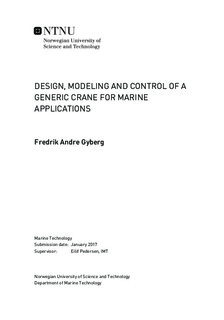DESIGN, MODELING AND CONTROL OF A GENERIC CRANE FOR MARINE APPLICATIONS
| dc.contributor.advisor | Pedersen, Eilif | |
| dc.contributor.author | Gyberg, Fredrik Andre | |
| dc.date.accessioned | 2017-04-24T13:28:38Z | |
| dc.date.available | 2017-04-24T13:28:38Z | |
| dc.date.created | 2017-01-16 | |
| dc.date.issued | 2017 | |
| dc.identifier | ntnudaim:16080 | |
| dc.identifier.uri | http://hdl.handle.net/11250/2440565 | |
| dc.description.abstract | This thesis is presenting the results and processes of designing a scaled down crane model that is intended for studying of crane behavior and control systems. The design process is performed as an iteration process with a system design approach. The objective is to develop a crane that will provide a solid basis for future research and testing. One of the most central parts of the work done and presented in this thesis is the de- velopment of a simulation model that is able to predict the behavior of several different configurations of the scaled down crane model. The usefulness of the simulation model during the design process of the crane is well documented throughout this thesis. Tests comparing the simulation model and the real crane is performed and documented, and the accuracy of the simulation model is demonstrated. The results found in the comparison is that the behavior predicted by the simulation model is more or less identical to the behavior of the real crane. This concludes that the methods and models used to create the simulation model presented in this thesis can be considered verry effective. The design of the crane is not only based on the results form the dynamic simulations. The structure have been analyzed with the use of final element analysis to make sure that the structure is in accordance with the design requirements. It has also been done several conceptual evaluations of the crane design regarding modularity and future expansion and modifications. This is done to making the crane a solid basis for further development and modification. A control system is developed and tested in both the simulation model and in the crane lab. The control systems is fairly basic and only consisting of controllers that control the speed of the motors powering the crane and the initiation of the winch brake. Even though the controllers are basic and only controlling one separate motor each the level of accuracy that is possible to achieve with this type of control has proven to be impressive. The controllers will therefore provide a good basis for further development of more sophisticated control of the crane. | |
| dc.language | eng | |
| dc.publisher | NTNU | |
| dc.subject | Marin teknikk, Marint maskineri | |
| dc.title | DESIGN, MODELING AND CONTROL OF A GENERIC CRANE FOR MARINE APPLICATIONS | |
| dc.type | Master thesis |
Files in this item
This item appears in the following Collection(s)
-
Institutt for marin teknikk [3410]

